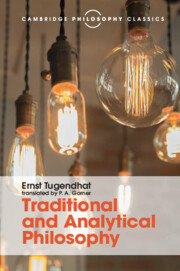Book contents
- Frontmatter
- Dedication
- Contents
- Preface
- Preface
- Translator's preface
- Part I Introduction: confrontation of analytical philosophy with traditional conceptions of philosophy
- Part II A first step: analysis of the predicative sentence
- 8 Preliminary reflections on method and preview of the course of the investigation
- 9 Husserl's theory of meaning
- 10 Collapse of the traditional theory of meaning
- 11 Predicates: the first step in the development of an analytical conception of the meaning of sentences. The dispute between nominalists and conceptualists
- 12 The basic principle of analytical philosophy. The dispute continued. Predicates and quasi-predicates
- 13 The meaning of an expression and the circumstances of its use. Dispute with a behaviouristic conception
- 14 The employment-rule of an assertoric sentence. Argument with Grice and Searle
- 15 Positive account of the employment-rule of assertoric sentences in terms of the truth-relation
- 16 Supplements
- 17 ‘And’ and ‘or’
- 18 General sentences. Resumption of the problem of predicates
- 19 The mode of employment of predicates. Transition to singular terms
- 20 What is it for a sign to stand for an object? The traditional account
- 21 The function of singular terms
- 22 Russell and Strawson
- 23 What is ‘identification’?
- 24 Specification and identification. Specification and truth
- 25 Spatio-temporal identification and the constitution of the object-relation
- 26 Supplements
- 27 Results
- 28 The next steps
- Bibliography
- Index of names
- Index of subjects
22 - Russell and Strawson
from Part II - A first step: analysis of the predicative sentence
Published online by Cambridge University Press: 05 August 2016
- Frontmatter
- Dedication
- Contents
- Preface
- Preface
- Translator's preface
- Part I Introduction: confrontation of analytical philosophy with traditional conceptions of philosophy
- Part II A first step: analysis of the predicative sentence
- 8 Preliminary reflections on method and preview of the course of the investigation
- 9 Husserl's theory of meaning
- 10 Collapse of the traditional theory of meaning
- 11 Predicates: the first step in the development of an analytical conception of the meaning of sentences. The dispute between nominalists and conceptualists
- 12 The basic principle of analytical philosophy. The dispute continued. Predicates and quasi-predicates
- 13 The meaning of an expression and the circumstances of its use. Dispute with a behaviouristic conception
- 14 The employment-rule of an assertoric sentence. Argument with Grice and Searle
- 15 Positive account of the employment-rule of assertoric sentences in terms of the truth-relation
- 16 Supplements
- 17 ‘And’ and ‘or’
- 18 General sentences. Resumption of the problem of predicates
- 19 The mode of employment of predicates. Transition to singular terms
- 20 What is it for a sign to stand for an object? The traditional account
- 21 The function of singular terms
- 22 Russell and Strawson
- 23 What is ‘identification’?
- 24 Specification and identification. Specification and truth
- 25 Spatio-temporal identification and the constitution of the object-relation
- 26 Supplements
- 27 Results
- 28 The next steps
- Bibliography
- Index of names
- Index of subjects
Summary
To tackle the question of what it means to speak of ‘objects’ and how a reference to objects is possible by asking how we can refer to objects by means of signs is already to adopt a language-analytical approach. However we have seen (pp. 299–300) that such an approach still leaves it open whether the answer to this question itself results in a specifically language-analytical position. This would consist in holding that the reference to objects to which the explanation of such signs points cannot be understood independently of the use of just such signs.
As with all signs the question of the mode of employment of these signs can only be tackled by asking how they can be explained. And in this case that means: how it can be explained, or established, for which object the expression stands (p. 281). To prepare for this question I enquired in the last lecture into the function of these expressions. What emerged there regarding the purpose for which singular terms are used and what it means to speak of ‘objects’ holds generally for all singular terms and all objects. We now know what in general is being asked when it is asked how it can be established for which object a singular term stands: one is asking which object is specified by the singular term, where ‘specify’ means: to pick out what is meant from a presupposed plurality.
If we now ask, not about the function, but about the explanation, or mode of employment of these expressions then precisely because of what we have seen regarding the function of these expressions the question can no longer be posed in a formal, general way. Rather a specific type of object, a specific plurality (that of perceptible objects or states of affairs or attributes, etc.) is presupposed and one asks how it is possible to pick out one object as the one meant from among all objects of this type. Thus the question left open in the last lecture, viz. how a singular term can specify an object, must be put separately for each type of object (and this is because the different types of object – though I have not shown this – are distinguished precisely by the manner in which they are specified).
- Type
- Chapter
- Information
- Traditional and Analytical PhilosophyLectures on the Philosophy of Language, pp. 307 - 320Publisher: Cambridge University PressPrint publication year: 2016

